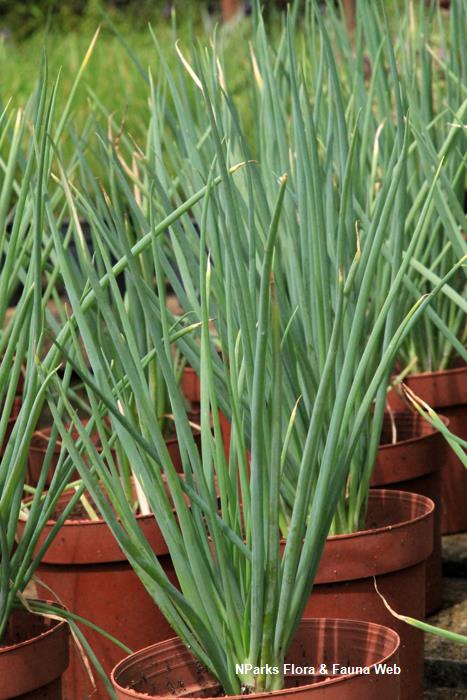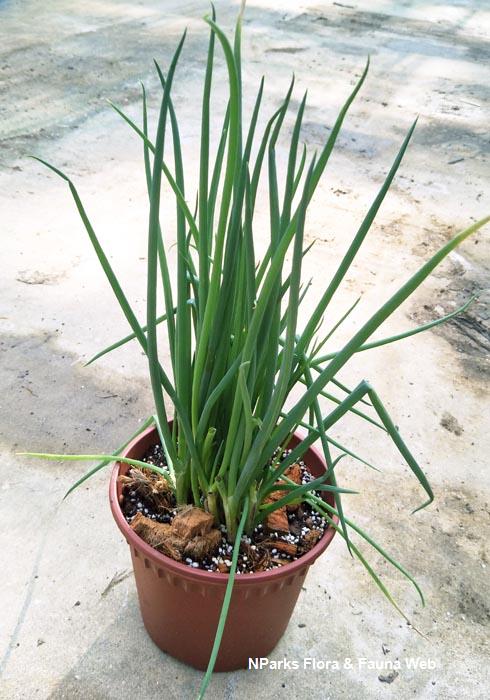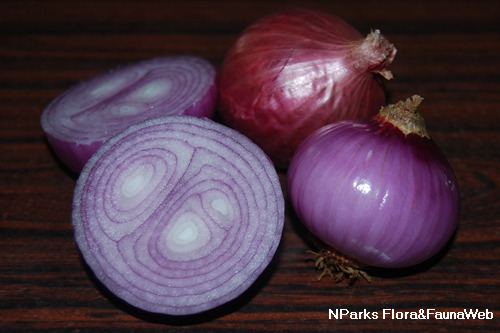
Back
Allium fistulosum L.
| Family Name: | Amaryllidaceae |
| Synonyms: | Porrum fistulosum |
| Common Name: | Spring Onion, Scallion, Green Onion, Bunching Onion, Welsh Onion, 葱 |
Name
Classifications and Characteristics
| Plant Division | Angiosperms (Flowering Seed Plants) (Monocotyledon) |
|---|---|
| Plant Growth Form | Herbaceous Plant |
| Lifespan (in Singapore) | Perennial |
| Mode of Nutrition | Autotrophic |
| Maximum Height | 0.3 m |
| Maximum Plant Spread / Crown Width | 0.6 m |
Description and Ethnobotany
| Growth Form | Perennial herb with indistinct bulbs that grows in clusters. The base of the stem is slightly swollen. Leaves held erect. This plant was cultivated from a wild onion that may have been Allium altaicum. |
|---|---|
| Foliage | Leaves are bluish-green, pointed hollow tubes (27 – 32 cm long, 0.5 – 0.7 cm wide at the base). |
| Flowers | Flowers small and white, have stamens that extend well past the petals. Flowers arranged in round umbel inflorescences and borne on green, hollow stalks similar to the leaves. |
| Fruit | Fruit initially green and becomes light brown and papery at maturity. Contains black seeds. |
| Others - Plant Morphology | Propagation: Propagate by seed or division of plants. |
| Cultivation | Although it is able to grow in semi-shade, the leaves tend to bend over. It is best grown under full sun in soil with good drainage and abundant organic matter. In Singapore, this plant grows continuously through the entire year. |
| Etymology | The genus name “Allium” is Latin for garlic. The species epithet “fistulosum” is Latin for fistular and refers to the hollow tube structure of the leaves. |
| Ethnobotanical Uses | Edible Plant Parts : Edible Leaves Food (Herb or Spice) Others: Food: Commonly added to Asian stir-fries as flavoring. Also used in soups and vegetable dishes. Both leaves and bulbs (white basal portion) are eaten. The leaves contain carotenoids that have antioxidant activity (eg, beta-carotene, lutein). Lutein was shown to improve the vision of patients with age-related macular degeneration, a disease that causes vision loss (Richer et al 2004). |
Landscaping Features
| Landscape Uses | Container Planting |
|---|---|
| Thematic Landscaping | Economic Garden |
Fauna, Pollination and Dispersal
| Pollination Method(s) | Biotic (Fauna) (Insects (Butterfly, Moth)) |
|---|---|
| Seed or Spore Dispersal | Abiotic |
Plant Care and Propagation
| Light Preference | Full Sun |
|---|---|
| Water Preference | Moderate Water |
| Rootzone Tolerance | Easy to Grow, Fertile Loamy Soils, Well-Drained Soils, Shallow Media |
| Maintenance Requirements | Low |
| Propagation Method | Seed, Division |
Foliar
| Mature Foliage Colour(s) | Green |
|---|---|
| Mature Foliage Texture(s) | Smooth |
| Foliar Type | Simple / Unifoliate |
| Foliar Shape(s) | Non-Palm Foliage (Linear) |
| Foliar Venation | Parallel |
| Foliar Margin | Entire |
| Foliar Apex - Tip | Acute |
| Foliar Base | Truncate / Square |
| Typical Foliar Area | Microphyll ( 2.25cm2 - 20.25 cm2 ), Notophyll ( 20.25cm2 - 45 cm2 ) |
Non - Foliar and Storage
| Stem Type & Modification | Herbaceous |
|---|---|
| Root Type | Underground (Fibrous Root) |
Floral (Angiosperm)
| Flower Colour(s) | White |
|---|---|
| Flower Symmetry | Radial |
| Inflorescence Type | Umbel |
Fruit, Seed and Spore
| Mature Fruit Colour(s) | Brown |
|---|---|
| Fruit Classification | Simple Fruit |
| Fruit Type | Dehiscent Dry Fruit , Capsule |
Image Repository
Others
| Master ID | 30635 |
|---|---|
| Species ID | 4944 |
| Flora Disclaimer | The information in this website has been compiled from reliable sources, such as reference works on medicinal plants. It is not a substitute for medical advice or treatment and NParks does not purport to provide any medical advice. Readers should always consult his/her physician before using or consuming a plant for medicinal purposes. |














